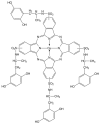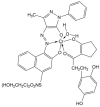Photons for Photography: A First Diagnostic Approach to Polaroid Emulsion Transfer on Paper in Paolo Gioli's Artworks
- PMID: 36296610
- PMCID: PMC9607993
- DOI: 10.3390/molecules27207023
Photons for Photography: A First Diagnostic Approach to Polaroid Emulsion Transfer on Paper in Paolo Gioli's Artworks
Abstract
The aim of this research is to study and diagnose for the first time the Polaroid emulsion transfer in the contemporary artist Paolo Gioli's artworks to provide preliminary knowledge about the materials of his artworks and the appropriate protocols which can be applied for future studies. The spectral analysis performed followed a multi-technical approach first on the mock-up samples created following Gioli's technique and on one original artwork of Gioli, composed by: FORS (Fiber Optics Reflectance), Raman, and FTIR (Fourier-Transform InfraRed) spectroscopies. These techniques were chosen according to their completely non-invasiveness and no requirement for sample collection. The obtained spectra from FTIR were not sufficient to assign the dyes found in the transferred Polaroid emulsion. However, they provided significant information about the cellulose-based materials. The most diagnostic results were obtained from FORS for the determination of the dye developers present in the mock-up sample which was obtained from Polacolor Type 88 and from Paolo Gioli's original artwork created with Polacolor type 89.
Keywords: Paolo Gioli; blue copper phthalocyanine; chromium (III) complex of azomethine dye; chromium complex of an azo pyrazolone; fibre optics reflectance spectroscopy; polacolor; polaroid chemistry.
Conflict of interest statement
The authors declare no conflict of interest.
Figures








References
-
- Blacklow L. New Dimensions in Photo Processes: A Step-by-Step Manual in Alternative Photography. Focal; Oxford, UK: 2007.
-
- Greenwald R.B. 4-Hydropyrazole Developing Agents. US4102684. 1977 September 20;
-
- Bloom S.M. Wayland, Boris Levy Image Receiving Elements. US43048US430483535. 1981 December 8;
-
- Fischer M. Short Guide to Film Base Photographic Materials: Identification, Care, and Duplication. Northeast Doc. Conserv. Cent. 2007;5:112–117.
-
- Wilker A. The Composition and Preservation of Instant Films. University of Texas at Austin; Austin, TX, USA: 2004.
MeSH terms
Substances
LinkOut - more resources
Full Text Sources

